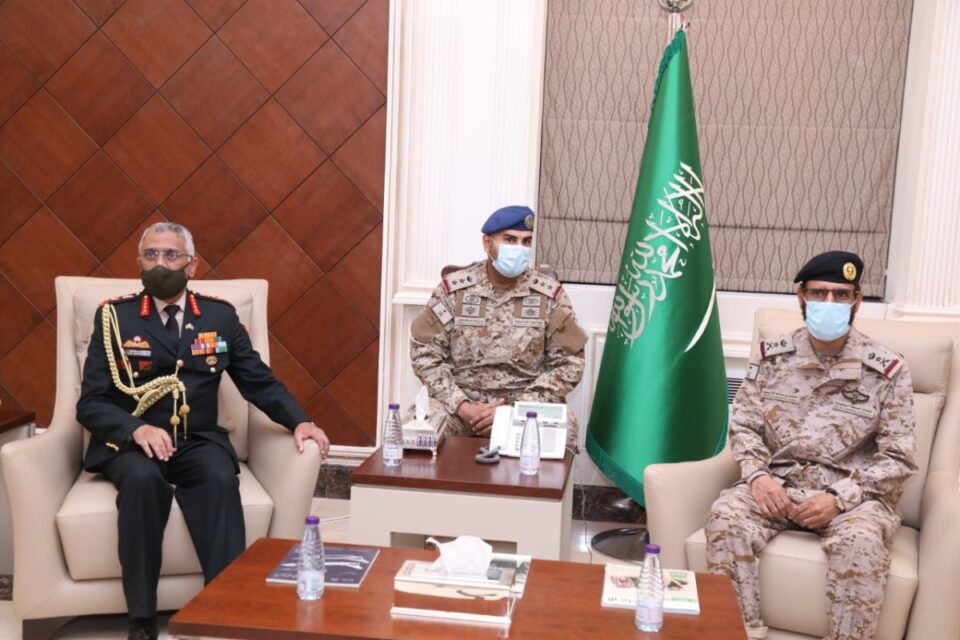General Naravane’s UAE and Saudi Arabia visits communicate India’s long awaited arrival in the domain of integrated foreign policy where the diplomatic and the military domains both complement each other much more substantially, observes Lieutenant General Syed Ata Hasnain (retd).
IMAGE: General Manoj Mukund Naravane, chief of the army staff, interacts with Lieutenant General Mutlaq bin Salim bin Al-Azima, commander of Saudi Arabia’s joint forces. Photograph: Kind courtesy ADG PI – Indian Army/Twitter
There was a time 25 years ago when many of the fortunate ones from the Indian Army who served with UN forces in Africa loved to break journey in Dubai to shop around a bit and fill up suitcases of goodies for their families.
That was about the degree of strategic importance the Indian Army accorded to the United Arab Emirates, the tiny conglomerate of seven little nations.
No one realised then that UAE which had created a trading and business hub of no mean proportion even at that stage would progressively go on to be a strategic heavyweight of the Middle East; it probably happened due to the UAE’s continuing economic status and very adroit handling of foreign relations.
Saudi Arabia on the other hand acquired its high strategic image from the contribution of three factors. First, the custodianship of the most important shrines of Islam, second the virtual leadership of the majority Sunni world and third because of the energy reserves under its control which gave it a booming economy.
General Naravane is the first-ever Indian Army Chief to officially visit the UAE and Saudi Arabia.
He was there last week and it drew considerable interest within India and internationally, especially since both nations have been steadfast and enduring in their support for India.
I inquired from some senior naval officers and learnt that Indian naval chiefs have been regularly visiting these countries in the past.
So why does a visit by the Army Chief draw so much attention? Before getting to discuss this and the strategic intricacies involved a few observations may be relevant.
First, in India’s foreign policy the military domain as an important adjunct of political diplomacy has found insufficient space.
Except for routine port calls by naval ships, visits by Service Chiefs and technical delegations to examine weapons and equipment there has hardly been a thought towards deliberately using the domain of military linkages to strengthen politico-strategic relationships in more than a transactional way.
This has long been a complaint of the Armed Forces.
Things started to change around 2005 when joint military training beyond just exchange of officers on courses of instruction became more frequent.
Of course, Exercise Malabar, the annual event with the US Navy began in 1992 soon after the end of the Cold War and the commencement of the reset of the world order.
Second, the uniform has a certain affinity as those who bear weapons are also known to establish better trust.
The current Indian government has been quick to realize the value of military to military relationships.
It may not be the best of examples, but the Pakistan army’s relationship with its counterparts in some other countries has been a force multiplier for the Pakistani nation at crucial times.
Among them are the US and Saudi Arabia.
My experience in working with the US army revealed that while dealing simultaneously with the Pakistan and Indian armies US officers would always favour the Pakistanis; it’s a longer standing relationship I suppose, going back to Cold War days.
The US armed forces are now beginning to judge the Indian military differently.
With 15000 Pakistani troops once posted in Saudi Arabia the two armies probably know each other well.
Third, the change in thinking in the Indian government has manifested in some much needed experimentation in military diplomacy; by having the Army Chief visit important nations where scope for the military domain to regain confidence and reset relations is high.
The government rightly chose Myanmar to start with; it’s where General Naravane served three years as a defence attache and his earlier contacts with the Myanmar army would have added much confidence when he and Foreign Secretary Harsh Shringla together visited Yangon in early November.
Since the Myanmar army traditionally plays an important role in the conduct of Myanmar’s foreign policy it made ample sense for the Army Chief to be a part of the outreach.
The same principle has been put to good effect in the case of Nepal with whom there was a diplomatic standoff which occurred almost in sync with India’s Ladakh standoff with China.
An important player in the matrix of Himalayan security Nepal cannot be wished away.
Swayed by its Communist leader, Nepal experimented with diplomatic confrontation with India without being sure how far to go.
General Naravane’s own remarks at that stage were not taken too kindly by Nepal.
Going ahead with a pending visit by the Army Chief was a suitable decision; after all 30,000 Nepalese Gurkha soldiers serve the Indian Army at any time under the Indo-Nepal Treaty of 1950 and thousands more receive pension for their similar earlier service.
The Army Chief ceremonially receives the honorary rank of general of the Nepal army which in General Naravane’s case was postponed due to the pandemic.
IMAGE: General Naravane visits the Saudi armed forces command. Photograph: Kind courtesy ADG PI – Indian Army/Twitter
So there has been a healthy and successful buildup to the Army Chief’s visit to UAE and Saudi Arabia.
This is in a way ‘reinforcing diplomacy’ considering the fact that the Indian government has invested much time and energy since 2014 in building its relationships with important Middle East nations; the Gulf region received greater priority in this with the UAE and Saudi Arabia both receiving the higher focus.
There are almost a total of 5 million Indian expatriates working in both countries sending home large and steady remittances.
India imports a large part of its energy needs from the two nations with a high degree of strategic assurance.
Both have now emerged as the two most important nations in the Gulf Cooperation Council.
The UAE commenced the process of signing of the Abraham Accords with the US and Israel becoming the first Arab nation after Egypt and Jordan to normalise relations with Israel.
This has contributed towards the stabilisation process of the Middle East, but opened schisms within the Islamic world.
Saudi Arabia itself has not yet signed an Abrahamic Accord although it enjoys a fine relationship with Israel in an effort to balance Iran’s growing power in the Middle East.
The power of Saudi Arabia and UAE in the OIC has in the last one year been challenged by an axis comprising Malaysia, Pakistan, Iran and Turkey (all non-Arab countries) all of whom are bound by an anti-India stance especially on the issue of J&K.
However, Pakistan has been attempting to regain its relationship with Saudi Arabia and UAE especially after it was asked to return a $3 billion loan and work visas of several Pakistani workers in the UAE were not renewed.
In the emerging scenario it is important for India for reinforce its relationship with GCC and especially with Saudi Arabia and the UAE.
In the political, economic and social domains the relationships have developed well.
It is the military field where something more transformational could be achieved.
Joint training between the armies had commenced a few years ago.
However, it is not just the hard core areas of cooperation that are up for demonstration.
What is equally needed is the right projection that a military to military relationship resting on contact at the highest levels has come to be established between India and the two nations.
If India has come thus far, it must not stop with the Army Chief’s isit.
Exchanges between institutions and even different Arms and Services will go a long way in seizing the space which has been occupied by Pakistan all these years.
The Navy and the Air Force will have as much to contribute.
General Naravane’s UAE and Saudi Arabia visits have occurred at a most appropriate juncture when a reset in the order of the Middle East is underway.
Besides anything else it also communicates India’s long awaited arrival in the domain of integrated foreign policy where the diplomatic and the military domains both complement each other much more substantially.
With a new US administration in place very soon it also communicates India’s willingness to experiment in establishing linkages which will eventually assist in the creation of the right balance of power in the Middle East.
Lieutenant General Syed Ata Hasnain (retd), PVSM, UYSM, AVSM, SM, VSM is one of India’s most respected commentators on national security.
The general commanded the Indian Army’s 15 Army Corps in Kashmir and was known as the ‘People’s General’ in the Kashmir Valley
General Hasnain is a frequent contributor to KhabriBaba.com.
Feature Presentation: Aslam Hunani/KhabriBaba.com




